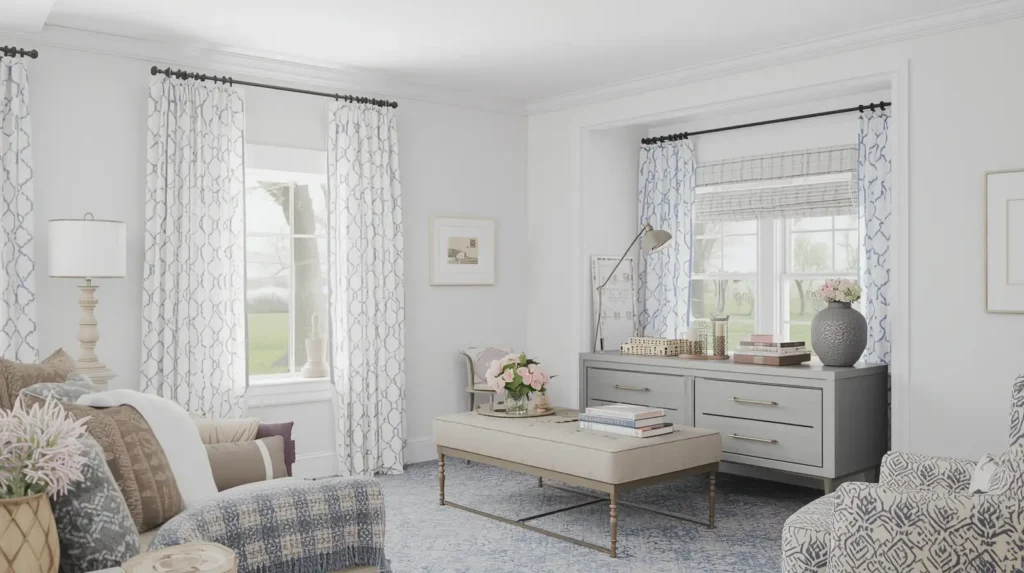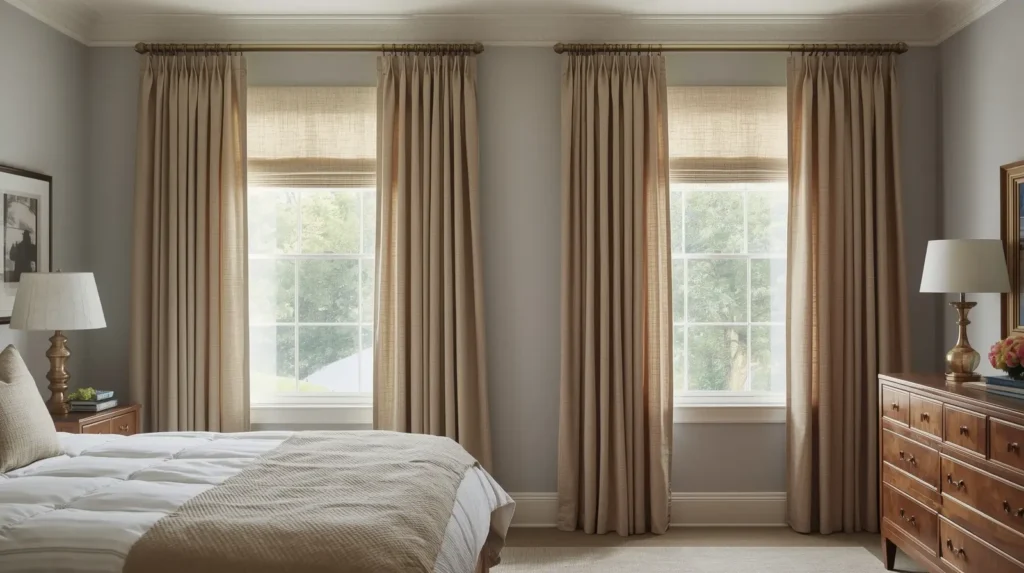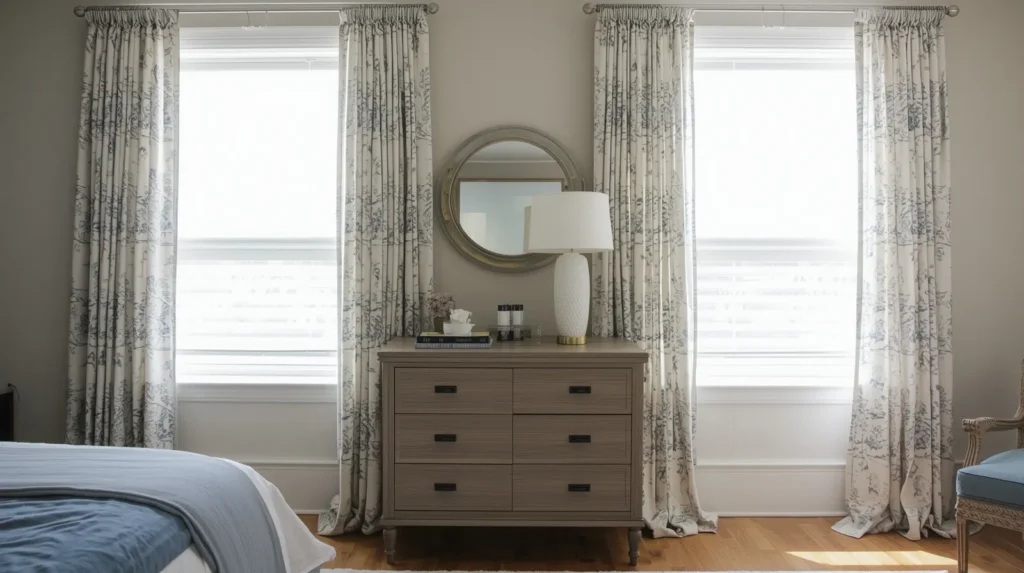So, how long should curtains be in bedroom? The best curtain length for most bedrooms is floor-length, meaning the curtains should just touch or slightly hover above the floor (about half an inch). This gives your room a polished, cozy, and balanced look. Short curtains can work for smaller windows or tight spaces, but long curtains usually look more elegant and help make the room feel taller and more spacious.
Why Curtain Length Matters More Than You Think
Curtains might seem like a small detail, but they have a big impact on how your bedroom looks and feels. They control light, add softness to the space, and play a key role in your room’s mood. The right curtain length can visually stretch your walls, make your ceilings appear taller, and bring a finished look to your entire décor.
Imagine two identical bedrooms one with short curtains stopping mid-wall, and one with long, flowing curtains that almost touch the floor. The second room immediately feels calmer, taller, and more intentional. That’s the power of curtain length.
Interior designers often say curtains act like the “frame” around your bedroom’s view. Without the right length, that frame can look off-balance. Long curtains feel graceful and cohesive, while short ones can feel abrupt unless they’re used for specific practical reasons.
So, even before you pick your fabric or color, think about how your curtain length will influence the way your bedroom feels when you walk in.
Understanding Bedroom Curtain Basics Before Choosing Sizes

Before you buy or hang your curtains, it’s important to understand the basics curtain sizes, rod placement, and how window proportions affect the overall design.
Curtains come in a few standard sizes like 63, 84, 96, 108, and 120 inches. However, your perfect size depends on how high you hang your curtain rod. Mounting your rod 6–8 inches above the window frame gives a more open, spacious feel.
There are three main types of curtain drops:
- Sill-length curtains: These end right at the window sill and work well for smaller or older-style bedrooms.
- Apron-length curtains: These hang just below the sill, perfect for casual or cottage-style spaces.
- Floor-length curtains: The most common and stylish choice for bedrooms, giving a soft, full, and elegant appearance.
Think of this as building a foundation. If your rod is too low or your curtain too short, the entire look can feel incomplete. On the other hand, properly measured curtains can make even a simple bedroom feel like a designer’s work.
How Long Should Curtains Be in Bedroom
The ideal curtain length for bedrooms is typically floor-length or slightly shorter about half an inch above the floor. This creates a neat, tailored look without letting the fabric drag and gather dust.
If you want a cozy, romantic touch, let the curtains just “kiss” the floor. This means the hem barely brushes the ground, which adds softness and elegance. For a more dramatic or formal look, some people choose “puddled” curtains fabric that extends 1–2 inches onto the floor.
Professional Tip: For busy households or homes with pets, hovering curtains (about half an inch off the floor) are practical and still stylish. They’re easy to clean around and don’t collect dirt.
In design terms, curtain length should match your personality and lifestyle. If you love a clean, modern look, go for precise measurements. If you love a dreamy, hotel-like atmosphere, try slightly longer panels that softly rest on the floor.
Ideal Curtain Length Explained in Simple Terms

When you hear “ideal curtain length,” it simply means choosing the length that fits your room’s height, design style, and daily use.
For example, a bedroom with low ceilings can instantly look taller when you hang your curtain rod closer to the ceiling and use long panels that go all the way to the floor. This vertical line draws the eyes upward, making your room appear larger.
For high ceilings, long curtains are almost always a must. They bring warmth and balance to tall walls that might otherwise feel empty.
If your bed or dresser sits below the window, you might consider apron-length curtains to keep things neat and accessible. But remember, shorter curtains are best reserved for specific situations most modern bedrooms look better with long ones.
Pro Insight: When in doubt, go longer rather than shorter. You can always hem extra fabric, but you can’t add length later.
Which Curtain Length Looks Best for Different Bedroom Styles
The right curtain length depends not only on your window height but also on your bedroom’s style. Let’s break it down by look and mood:
- Modern or Minimalist Bedrooms: Clean, floor-grazing curtains that hover just above the ground create a crisp, uncluttered feel. Think neutral tones and light fabrics like linen or cotton.
- Classic or Traditional Bedrooms: Floor-length curtains that gently touch the floor give a timeless, graceful appearance. Heavier fabrics like velvet or damask work beautifully here.
- Coastal or Relaxed Bedrooms: Curtains that float about one inch above the floor allow for easy air circulation and give a breezy, casual look.
- Romantic Bedrooms: Try curtains that “puddle” slightly. That extra fabric creates softness and gives a sense of luxury.
Each style tells a story. The secret is choosing a curtain length that matches your room’s personality. For instance, pairing long velvet curtains with modern furniture might clash, but pairing them with antique wood tones can look stunning.
Design harmony is the goal and curtain length is one of the easiest ways to achieve it.
Bedroom Curtain Sizes: How to Measure for a Perfect Fit
Getting your curtain length right starts with proper measuring. Here’s how to do it like a pro:
- Decide where to mount your curtain rod. For a taller appearance, mount it several inches above the window frame.
- Measure from the top of the rod (not the window) to the point where you want the curtain to end usually the floor.
- Account for curtain style. If you want them to kiss or puddle, add an inch or two.
- Measure window width and multiply by two. This ensures full, gathered coverage even when closed.
For example, if your window is 50 inches wide, your curtain panels should total about 100 inches in width. This keeps them from looking flat or too tight when drawn.
Expert Tip: Always measure twice. It might seem simple, but curtain length errors are among the most common mistakes homeowners make. Measuring correctly saves money, time, and frustration.
At CV Floor & Blinds, we’ve seen how custom-length curtains elevate a bedroom instantly. When curtains perfectly fit the window and touch the floor neatly, the entire room feels more peaceful and complete.
Short Curtains vs Long Curtains Which Works Better in Bedrooms
Let’s settle this debate once and for all.
Short curtains:
- Work best for children’s rooms or small windows above furniture.
- Are easy to clean and maintain.
- Can feel casual or playful in design.
Long curtains:
- Make ceilings look taller.
- Add elegance, warmth, and softness.
- Are more flexible across different design styles.
A good way to decide is by considering room purpose. A master bedroom benefits from long, elegant curtains, while a kid’s room may need shorter ones for practicality.
Imagine standing in a hotel suite every curtain you see touches the floor. That’s not an accident; it’s design psychology. Long curtains frame the window and ground the entire space, giving your eyes a natural flow from top to bottom.
So, when comparing short curtains vs long curtains, long wins for adults, style, and comfort.
Should Bedroom Curtains Touch the Floor or Stop Short

This question comes up often, and the answer depends on your personal taste and maintenance habits.
If you like neat and tidy spaces, have your curtains hover half an inch above the floor. It’s practical, especially if you vacuum often or live in a dusty environment.
If you love luxury or dramatic style, go for curtains that touch the floor or have a small “puddle” of fabric. These create a soft, layered effect that looks great in cozy bedrooms.
However, avoid curtains that hang awkwardly several inches above the floor. They make the window look unfinished and smaller than it really is.
Professional Advice:
- In busy homes, hovering curtains are best.
- In formal or guest bedrooms, floor-touching curtains add warmth and sophistication.
- If your floor is uneven, slightly hovering curtains will keep everything looking even.
This balance between beauty and practicality is key to making your bedroom feel both clean and comfortable.
Common Mistakes When Choosing Curtain Length
Even with all this information, many homeowners still run into problems. Here are the biggest mistakes to avoid:
- Guessing measurements: Always measure your windows and rod placement. Guessing often leads to costly re-dos.
- Buying pre-sized curtains without checking your wall height: Not all ceilings are standard height, and pre-sized curtains might fall short.
- Hanging rods too low: Mounting the rod just above the frame makes the window look smaller. Raise it higher for a designer touch.
- Forgetting about furniture placement: A headboard or nightstand under the window might affect your curtain length choice.
- Choosing fabric that’s too stiff: Heavy or stiff materials don’t drape nicely at floor-length. Opt for soft fabrics that flow.
Example:
A homeowner once installed 84-inch curtains for their 9-foot ceilings. The result? The curtains ended 6 inches too short, making the room feel awkwardly cut off. Once replaced with 96-inch panels, the whole room looked taller and more balanced.
Small adjustments like this can completely transform the way your bedroom feels.
Expert Tips from CV Floor & Blinds for Beautiful Results in Coachella, CA
At CV Floor & Blinds, we’ve helped countless homeowners find the perfect curtain length and fabric combination for their bedrooms. Here are some expert tips that can make your space stand out:
- Match your curtain color to your wall undertones. This creates harmony and prevents visual clutter.
- Layer curtains and sheers. This allows light control and privacy while maintaining elegance.
- Always go wider than your window. Extend the rod at least 4–6 inches past each side of the window frame. This makes windows look larger.
- Steam your curtains after hanging. Wrinkles can make even expensive fabric look cheap.
- Invest in good hardware. Quality rods and rings make a difference in how smoothly curtains move and how long they last.
When done right, your curtains won’t just look beautiful they’ll enhance your sleep environment. Proper light control means you can rest better while enjoying a room that feels stylish and complete.
Final Thoughts: Creating a Balanced, Cozy Bedroom with the Right Curtain Length
Curtains are one of those design elements that often get overlooked but make one of the biggest impacts once installed correctly.
The perfect curtain length brings everything together the bed, the windows, the light, and the walls. It makes your room feel taller, softer, and more cohesive. And while there are general rules to follow, your personal taste and comfort always come first.
If you ever feel uncertain, remember this: Curtains that touch or nearly touch the floor will almost always look right. They’re timeless, practical, and flattering to nearly every room style.
So whether you’re redecorating your entire home or just freshening up your bedroom, take the time to measure carefully and visualize the final result. The few extra minutes you spend planning will reward you with years of comfort and beauty.
Ready to transform your bedroom? Contact CV Floor & Blinds today for expert help choosing, measuring, and installing your dream curtains. Our team can guide you through styles, fabrics, and lengths to create a bedroom that looks as good as it feels.




